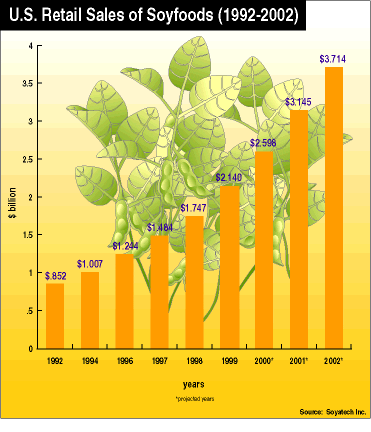From thyroid disease to GMOs, from breast cancer to infant formula, there’s been a lot of conflicting media reports on the safety of soy. We review the evidence, and explain the source of soy’s power as potential hero or villain.
What is soy?
The soybean plant originated in China and made its way to North America in 1765. Soy production in North America started as a means to feed animals, only becoming a food crop for humans in the early 1900s.
Genetic modification of soybeans was introduced in 1995; today, about 90% of the soybeans grown are genetically modified.
Soybeans may contain up to 48% protein with a PDCAA score (a measure of protein quality) just below 1.0, with soy protein isolate at 1.0. 1.0 is the highest score a protein can get, and soy ranks up there with milk, beef, and egg proteins.
The ratio of omega-3 to omega-6 fat in soybeans is about 1:7, which is sensible, especially when compared to oils like sunflower and peanut which are 1:100+.
Soybeans contain a mix of slow-digesting carbohydrates, including fibre and other starches that may be good for promoting the growth of healthy bacteria in the gut. Thus, for people who do not have an intolerance to soy, soy could be considered GI-friendly.
What you should know about soy
Cultural observation tells us that most traditional cuisines in Asia don’t incorporate soy as a staple food. The average soy intake in East Asian populations is between 40 – 90 grams per day (1.5 to 3 ounces). That’s total soy intake (not soy protein grams).
This amount of soy provides 10 – 20 grams of soy protein. Soy foods are typically used as a condiment to the main dish and used in a “whole food” form such as edamame, or fermented, as in miso, tofu, natto and soy sauce.
In North America, refined soy products such as soy concentrates, textured soy, and soy lecithin are finding their way into more processed foods. Between 2000 and 2007, U.S. food manufacturers introduced over 2,700 new foods with soy as an ingredient.
These forms of processed soy are what most people equate with soy consumption (rather than the whole food and fermented forms in traditional Asian cuisines).

Why is eating soy so important?
Hundreds of foods, including soy, contain phytoestrogens (PEs), also known as isoflavones (a type of flavonoid — the same flavonoids that make tomatoes, green tea and red wine “healthy”).
In the plants, they serve as a defense mechanism and fungicide. In humans, PEs, which include genistein, daidzein and glycytein, act as natural estrogen receptor modulators.
PEs are similar in structure to estradiol, a form of human estrogen. They have both weak estrogen-stimulating and estrogen-inhibiting effects, depending on the circumstance.
The UK Committee on Toxicity (2003) noted that PEs bind weakly to the sex-hormone binding proteins and are unlikely to prevent estrogen or androgen binding (at normal blood levels).
PEs provide the basis for much of the current soy controversy. When soy protein isolates and concentrates are created from soybeans, PE (and phytonutrient) content is diminished due to the alcohol used in extraction. However, some remain.
Phytoestrogen content of selected foods
| Food | Serving | Total PEs (mg) |
| Soy protein concentrate, water wash | 3.5 oz | 102 |
| Soy protein concentrate, alcohol wash | 3.5 oz | 12 |
| Miso | ½ cup | 59 |
| Soybeans, cooked | ½ cup | 47 |
| Tempeh | 3 ounces | 37 |
| Soybeans, dry roasted | 1 ounce | 37 |
| Soy milk | 1 cup | 30 |
| Tofu based yogurt | ½ cup | 21 |
| Tofu | 3 ounces | 20 |
| Soybeans, green, cooked (Edamame) | ½ cup | 12 |
| Soy hot dog | 1 hot dog | 11 |
| Soy sausage | 3 links | 3 |
| Soy cheese, mozzarella | 1 oz | 2 |
A traditional daily intake of soy for someone may include 6 ounces of tofu, a half-cup or soy milk, and a ½ cup of edamame. That would provide roughly 75 mg of PEs.
This is well below the amount necessary for having an unfavorable influence on hormone levels. However, as the chart above shows, a high intake from some processed soy products could easily provide much more.
We still can’t predict exactly how PEs will function after we swallow them. The actual effects depend on total amount of PEs in the body, receptor binding affinities, and possibly a host of genetic factors.
Despite these mixed results and a lack of consensus, there is a common theme: extremely high levels of PEs have an unfavorable influence on hormone levels for both men and women, and may inhibit muscle gain and fat loss to some degree.
Soy and cancer
Prostate cancer is low in countries that regularly consume soy and rodent studies have also found that PEs inhibit the development of prostate cancer and prostate tumor metastasis.
Soy and PE consumption does not seem to affect the endometrium in premenopausal women, although there have been weak estrogenic effects reported in breast tissue. Thus, studies in women have mostly shown beneficial effects (in cancer prevention), although the magnitude of the effects is small and of vague significance. If someone has existing cancer, it’s critical to know if the cancer is estrogen receptor positive. If it is, then it may be wise to avoid foods with a higher PE content.
Soy and pregnancy
Although there are still questions regarding in utero or early postnatal exposure, the low potencies and concentrations of PEs in the diet compared with the hormones manufactured in the body make it unlikely that adverse effects occur at common exposure. PEs in mom’s diet will appear in breast milk, but PE intake of breastfed infants is negligible. The American Association of Pediatrics cautiously recommends giving soy-based formula to infants, but only in cases where other options are insufficient.
Soy and sperm
There is a body of research in which controlled amounts of soy were fed to humans or primates and no negative effects on quantity, quality, or sperm motility were noticed. Could eating a lot more soy potentially lower sperm count? Sure. Is it something you should be concerned with? Probably not, unless you’re trying to make those sperm earn their rent.
Soy and bones
A meta-analysis (done on women) showed a significant benefit of PEs on spine bone density, especially when PEs were given in higher doses and for longer periods. A second meta-analysis showed that PEs significantly increased bone formation and decreased bone breakdown. Translation = soy PEs could be helpful for bones.
Soy and body composition
A review found that individuals lost equivalent amounts of weight (and inches in some cases), using soy protein, dairy milk meal replacements, and beef or pork at equal calorie levels. When soy protein supplements are used as part of a sensible training program and varied, calorie-sufficient diet, they act much in the same way that other protein supplements might act: increases in lean body mass, decreases in stress hormone responses to training, and improvements in performance. (See, for example, this study.)
Soy and anti-nutrients
Soy foods contain trypsin inhibitors and phytic acid, substances that can inhibit nutrient absorption. These substances are deactivated by cooking and fermentation. Thus, consuming cooked and fermented soy foods is unlikely to inhibit protein and mineral absorption. Also, phytic acid may have anti-cancer properties. Goitrogens found in soy (and other vegetables) only seem to cause thyroid problems when iodine intake is low and soy intake is high. Iodine can be obtained naturally from foods such as sea salt and sea vegetables (aka seaweed, e.g. kelp, dulse, etc.)
Soy and the heart
Heart health is influenced by the sum of one’s diet and lifestyle, not an ounce of miso. Small amounts of whole soy foods may help to control cholesterol levels.
Soy and the kidneys
Soy protein, despite being of high quality, doesn’t appear to have the same effect on kidney function that occurs in response to animal proteins. So, if your doc, or your mom, still gets worried about the high protein meals, mix in some soy for good measure.
Other interesting information about soy
The World Health Organization has identified soy as a high quality protein that can meet all of the essential amino acid requirements of humans.
Soy sauce and soy oil do not contain PEs.
Tamoxifen has long been an effective treatment for women with estrogen receptor positive breast cancer. In a study conducted in mice, researchers found that when genistein (a PE) is consumed as part of the daily diet, it can stop the ability of tamoxifen to halt breast cancer growth.
Summary and recommendations
In general, it’s hard to go wrong with whole, unprocessed foods. Problems typically occur with processed food, in all forms including soy.
Manufacturing processes remove the dietary fibre, carbohydrates, fats, vitamins, minerals, and hundreds of other helpful plant chemicals — leaving behind almost pure soy protein. The whole is healthier than the parts.
Although some studies show limited or conflicting results, when viewed in its entirety, the current literature supports the safety of PEs as typically consumed in diets that include small amounts of whole soy foods.
It seems best to avoid consuming isolated and highly refined forms of soy (such as soy isolates, soy concentrates, textured soy protein, etc.) on a regular basis. Whole soybeans, soy milks, tofu, tempeh, and miso, on the other hand, are better options.
In terms of total intake, we’d say 1-2 servings (a serving is 1 cup of soy milk and 4 ounces of tofu/tempeh/soybeans) of soy per day seems to be a safe and potentially healthy intake, but exceeding 3 servings per day on a regular basis may not be a good idea.
We don’t think soy is anything special in terms of disease prevention. Nor do we think it’s extremely harmful in your quest for optimal health, body comp, or performance. With that said, we do caution against excessive soy intake.
References
Click here to view the information sources referenced in this article.
Learn more
Want to get in the best shape of your life, and stay that way for good? Check out the following 5-day body transformation courses.
The best part? They're totally free.
To check out the free courses, just click one of the links below.




Share